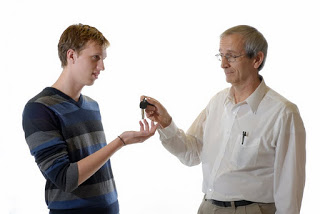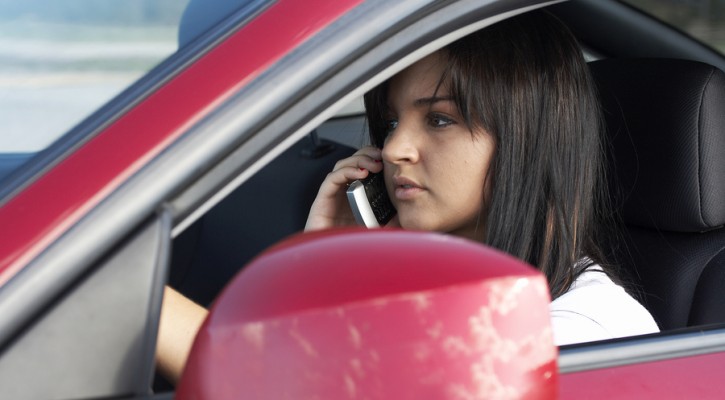Category Archive: Learners Permit Tips
Driver Education: How Drugs Affect Driving – Inhalants
June 17, 2009
Most parents worry that their teens will get involved in illegal drugs, but some parents are unaware of one of the main determinants of whether teens will experiment with drugs – availability. Because they are legal, easily accessible household products, inhalants are one of the most commonly abused drug categories. According to the 2007 Partnership Attitude Tracking Study, 4.6 million teens have tried inhalants. After alcohol, cigarettes, and marijuana, inhalants are the most frequently-used drug by teens. According to the Drug Enforcement Administration, inhalants are one of the first substances abused by children. Though addiction is rare, inhalants can act as a gateway drug when they are replaced with other accessible substances as children age and chase the next high.
Inhalants include solvents, such as paint thinner, gasoline, and glue; gases, such as butane, propane, and nitrous oxide; and aerosol propellants. Experimentation could occur with any household product containing chemicals – spray paint, cleaning products, felt-tip marker fluid, vegetable oil spray, correction fluid. Inhalants are “sniffed” from an open container or “huffed” from a rag soaked in the substance and held to the face. According to the National Institute on Drug Abuse, most inhalants cause a quick high similar to alcohol intoxication. The intoxication from inhalants typically only lasts a few minutes, so users often inhale repeatedly over a period of several hours, increasing the risk of adverse effects.
Effects of inhalants include:
- stimulation
- loss of inhibition
- slurred speech
- loss of motor coordination
- headache
- nausea or vomiting
- wheezing
- loss of sensation
- loss of consciousness
- muscle cramps and weakness
- memory impairment
- weight loss
- depression
- damage to the cardiovascular and nervous systems
- sudden death, even with first-time use
Because abuse of inhalants often occurs at a friend’s house or in out-of-the-way places such as in empty parking lots and on dead-end streets, and because driving is viewed as a fun activity by teens, the danger of inhalants can be compounded when teens use inhalants and drive. The intoxication caused by inhalants can cause the same problems as driving under the influence of alcohol – impaired judgment and decision-making, risky driving behavior, and poor motor coordination.
Ensuring that teens don’t experiment with inhalants requires a high degree of vigilance on the part of the parent. Inhalants are cheap, legal and easy to obtain, often from the teen’s own home. Teens are often not aware of the risk of using inhalants, reasoning that they are harmless household products and that they are only going to be used occasionally. In fact, the 2007 Partnership Attitude Tracking Study showed that from 2001 to 2005, the number of teens who perceived inhalant use as risky decreased significantly.
Parents shouldn’t assume that if they don’t mention inhalants, it won’t occur to teens to use them. At any given time, a teen can be presented with the idea by a friend. In fact, since inhalants are often the first drug used by children, they should be one of the first drug categories parents discuss. Make sure teens know that even common household goods, such as cleaning products, can be harmful – show them the warnings on the labels about using them in well-ventilated areas, and ask them to explain how they think intentionally inhaling the fumes could harm someone. Talk about the risk of sudden death from sniffing or huffing, and ask teens to talk about how they would feel if they were with a friend who died from inhalant abuse. Opportunities for reinforcing the risks of inhalant abuse are everywhere – in driver training courses, in health education classes, in newspaper articles, and on television shows.
Restricting the availability of popular substances is also important. Clean out the garage and properly dispose of leftover chemical products. Those that must be kept should be locked in a cabinet or shed. Parents may wish to help teens avoid temptation by limiting or banning aerosol spray products such as deodorants, hairspray, fabric protector, and whipped cream. Keep a close watch on teens’ bedrooms and recreational areas for empty containers or smelly rags, especially in odd places, like under a bed or chair or in the back of a closet. Parents who suspect inhalant abuse must take action immediately.

Ten Tips for New Drivers Before and After Getting Licensed
February 12, 2009
Tips for Before you Get Your Drivers License:
1. Learn the material in your driver handbook, not just so you can pass the test, but so you can carry the information into your driving behavior.
2. Memorize the graduated licensing laws in your state. Not only must you follow them, but you shouldn’t ride with anyone who isn’t following them.
3. Talk to your parents about their expectations and the rules you’ll have to follow to use the family car or get your own vehicle. The time to refine the rules is now, before you have your license.
4. Encourage your parents to let you practice driving in unfamiliar areas, at night, when it’s raining, and on expressways, not just on familiar streets close to home during daylight.
5. Learn to scan the driving scene ahead so you can anticipate problems and react in time. Ninety percent of driving decisions are based on what you see.
Tips for After you Get Your Drivers License:
6. Sign a driving contract with your parents, specifying driving rules and curfews. Incorporate your state’s graduated licensing laws into the contract. The contract should include an agreement for your parents to pick you up, no questions asked until the next day, should you be unable to drive or ride with someone else for any reason.
7. Ask your parents to let you continue practice-driving occasionally; every new driver can use the extra training.
8. Minimize distractions in your vehicle. Keep the radio volume low, put your cell phone away, and ask passengers to minimize conversation. Wear your safety belt and make sure all your passengers wear theirs.
9. NEVER use driving as a stress-reliever. Drivers who do this often speed or get distracted. Learn to manage stress in healthy ways – by taking a walk, taking a nap, talking to a friend, or volunteering.
10. Read the warning labels on any medicines, including over-the-counter (those that don’t require a prescription); many medications cause sleepiness or dizziness and shouldn’t be taken while driving. Read our most recent post on Teen Drivers and Prescription Drugs.
And of course, NEVER drink and drive.

Teaching Your Teen to Drive
February 3, 2009
Teaching your teen to drive is an exciting and highly anticipated rite of passage that means greater independence lies ahead. It may also be a time of mixed emotions. Many parents look forward to the day when they won’t be their teen’s main source of transportation, but they may also feel anxious about how safe their teen will be behind the wheel.
A plan of action will reduce the anxiety you feel about teaching your teen to drive. There are several actions you can take before you even allow your teen behind the wheel.
New drivers copy driving behaviors they have witnessed for years as passengers. Since they have probably ridden most often with parents, those behaviors are the ones they will imitate. To some parents, this is a somewhat frightening prospect. To make matters worse, teens who integrate risky driving practices into their own behavior do so without the benefit of years of experience and highly developed skills. Before you begin teaching your teen to drive, consider your own driving habits and make a commitment to correct any careless or reckless behavior and model good defensive driving practices consistently.
Another important aspect of teaching new drivers is good communication. Teens tune out lectures, so parents should work on developing a conversational rapport about safe driving with their children. Try to be concise; avoid going off on tangents. Ask for your teen’s opinion on hazards in your driving environment. For example, if you see children playing near the street, ask your teen to explain the risks and how to handle them. You can fill in details garnered from your own experience after your teen has a chance to be heard. Although it’s important to talk about driving risks, avoid horror stories. Instead, look for driving-related newspaper articles or subscribe to the National Safety Commission’s Safe Driving Teen Monthly Bulletin and discuss the articles together.
To help your teen understand more about the costs and responsibility of driving, review your insurance policy together, visit your insurance company’s website together, or pay a joint visit to your insurance agent’s office. Explain, or ask your agent to explain, the purpose of motor vehicle insurance. Discuss the cost of insurance and how the cost of your policy might increase or decrease. Ask your insurance agent whether a driver education course will result in a discount. Find out how much your insurance premium will increase after a single ticket or crash.
For many parents, driving is such an ingrained habit that they must refresh their knowledge about fundamental driving concepts. Doing so can only help you to be a better driving instructor to your teen, which in turn will help your teen be a better, safer driver.

Five Worst Teen Driving Mistakes: Part Five
January 20, 2009
Most parents live in dread of the day their teens get a driver’s license and get behind the wheel alone. Their concerns are well-founded, since teen drivers have the highest death rates in car crashes of any age group. Motor vehicle crashes are the number one cause of death among Americans aged 15-20.
In this five-part series, we’ll discuss the five worst teen driving mistakes:
-They don’t wear safety belts.
-They drink and drive.
-They panic/overcorrect in emergency situations.
-They drive too fast for conditions.
-They ride with other teens.
In this, part five of the series, we’ll discuss a frequent cause of injury and death in traffic crashes for teens – even when they aren’t driving. Riding with other teens is a high-risk activity that your teen will probably participate in even before earning a driver’s license.
No matter how skilled a driver your teen is, s/he is still at risk when riding in a vehicle driven by another teen. And it’s common for teens to pack a vehicle full of friends who are unlicensed or who don’t have access to a vehicle or to save money on gas. Unfortunately, they also do this because it’s fun to listen to music, laugh and talk – huge distractions for an inexperienced driver. According to the National Highway Traffic Safety Administration, crash risk for teenage drivers increases incrementally with one, two or three or more passengers. With three or more passengers, fatal crash risk is about three times higher than when a beginner is driving alone. About two-thirds of all crash deaths of teens that involve 16-year-old drivers occur when the beginners were driving with teen passengers.
Studies indicate that passenger restrictions can reduce this problem. Passenger restrictions for teen drivers already exist in many states as components of graduated licensing programs. For parents, knowing and enforcing these passenger restrictions means reducing their child’s risk of injury or death in a traffic crash. While this sounds easy enough, many parents are unfamiliar with the graduated driver licensing laws in their state. And even those who are familiar may neglect to enforce the restriction. A 2000 survey by the Insurance Institute for Highway Safety found that 84 percent of parents of young drivers favored restricting teenage passengers during the first six months of licensure. But some studies indicate that parents leave enforcement of most graduated licensing restrictions to law enforcement – a mistake, since law enforcement does not have the ability to monitor the behavior of an individual teen the way parents do.
To help ensure the safety of your teen, learn the graduated driver’s licensing laws in your state, and make enforcement of them part of your house rules. Monitor your teen’s driving behavior, and review the restrictions often.
Although parents often want their teens to get driver’s licenses so they can transport themselves to school, work and social activities, parents also worry about the risks. Make sure your home driver education program is complete by using a log to keep track of your teen’s progress.

Why You Should Take a Drug and Alcohol Course: A Note about Marijuana and Driving
January 5, 2009
Of course, a Florida drug and alcohol course is mandatory; you’ll have to take it so you can get your driver’s permit. But a certificate isn’t the only thing you should take away from the class – the knowledge you gain could one day save your life.
Drinking alcohol and driving gets a lot of attention, both in driver’s education courses and in the media, and it should; many teens die in alcohol-related crashes each year. But some teens forget about or ignore the effects of illegal drugs on driving, particularly with drugs that are incorrectly perceived to be harmless, like marijuana. But marijuana, whether used alone or in combination with alcohol, is anything but harmless for any driver.
By far, marijuana remains the most widely used illegal drug among teens. The main active chemical in marijuana is THC (delta-9-tetrahydrocannabinol). Short-term effects of marijuana use include problems with memory and learning, distorted perception, difficulty in thinking and problem-solving, loss of coordination, and increased heart rate, anxiety, and panic attacks.
After alcohol, marijuana is the substance most frequently found in fatal automobile crashes. Even a moderate dose of marijuana can impair driving performance. Alcohol and marijuana are also often found together, resulting in a dramatic spike in impairment levels and decreased driving performance. The effects of a low dose of marijuana combined with alcohol are much greater than for either drug alone.
Combining any two drugs, or a drug with alcohol, may result in the synergistic effect. This means that the combination of drugs produces effects that are greater than the sum of the effects of the two drugs. This is called an additive effect; instead of a 1 + 1 = 2 result, the synergistic effect may cause a 1 + 1 = 3 result.
Remember, any drug that affects your safe driving can mean a DUI – or worse.
Getting your Florida learner’s permit requires certain steps. Here is a useful Learners Permit checklist to get you started.
